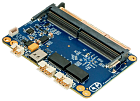 Quark
Carrier for NVIDIA Jetson Xavier NX & Nano
Connect Tech’s Quark Carrier for NVIDIA® Jetson Xavier™ NX & Nano is an affordable, ultra small, and feature rich carrier for AI Computing at the Edge. Just slightly larger than the Jetson SODIMM module, it’s ideal for vision applications, inference, and unmanned payloads.
Quark’s design includes a rich I/O set including 1x USB 3.1, 2x GbE, 2×2-lane MIPI CSI-2, 1x USB OTG, 1x SD card slot, 3×3.3V UART, 2 x I2C, 1x CAN 2.0b, and 1x SPI as well as positive locking IO connectors optimized for rugged environments.
NOTE: Do not use the 19V power supply from the Jetson Xavier™ NX Dev Kit with the Quark Carrier.
Quark
Carrier for NVIDIA Jetson Xavier NX & Nano
Connect Tech’s Quark Carrier for NVIDIA® Jetson Xavier™ NX & Nano is an affordable, ultra small, and feature rich carrier for AI Computing at the Edge. Just slightly larger than the Jetson SODIMM module, it’s ideal for vision applications, inference, and unmanned payloads.
Quark’s design includes a rich I/O set including 1x USB 3.1, 2x GbE, 2×2-lane MIPI CSI-2, 1x USB OTG, 1x SD card slot, 3×3.3V UART, 2 x I2C, 1x CAN 2.0b, and 1x SPI as well as positive locking IO connectors optimized for rugged environments.
NOTE: Do not use the 19V power supply from the Jetson Xavier™ NX Dev Kit with the Quark Carrier.
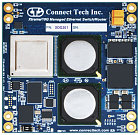 Xtreme-10G
Managed Ethernet Switch/Router
Connect Tech’s Xtreme/10G Managed Ethernet Switch/Router provides high density, high port count Layer 2 switching and Layer 3 routing with 10G uplinks. A total of 36 switchable ports, with 4×10G, 8×1GbE (SGMII), and 24×1GbE (Copper 10/100/1000Mbps) ports in an extremely small form factor 85mm x 85mm.
The device targets managed Layer 2 and Layer 3 equipment in SMB, SME, and industrial applications where high port count 1GbE switching with 10G aggregation/uplinks are required.
Xtreme-10G
Managed Ethernet Switch/Router
Connect Tech’s Xtreme/10G Managed Ethernet Switch/Router provides high density, high port count Layer 2 switching and Layer 3 routing with 10G uplinks. A total of 36 switchable ports, with 4×10G, 8×1GbE (SGMII), and 24×1GbE (Copper 10/100/1000Mbps) ports in an extremely small form factor 85mm x 85mm.
The device targets managed Layer 2 and Layer 3 equipment in SMB, SME, and industrial applications where high port count 1GbE switching with 10G aggregation/uplinks are required.
 Mini PCIe GbE
Gigabit Ethernet Mini PCIe module
Connect Tech’s Mini PCIe GbE boards are rugged, low cost Gigabit Ethernet Mini PCIe modules that are ideal for adding extra Ethernet capabilities to any system with minimal increase in overall system size and power consumption.
The modules utilize PCIe signaling which allows it to be used in any Mini PCIe socket that supports PCIe. The wide operating temperature, latching Ethernet connector and cabling solution allows these modules to be used in harsh environments.
Compatibility with a large variety of popular operating systems allows these boards to be easily integrated into a wide array of new and existing systems.
Mini PCIe GbE
Gigabit Ethernet Mini PCIe module
Connect Tech’s Mini PCIe GbE boards are rugged, low cost Gigabit Ethernet Mini PCIe modules that are ideal for adding extra Ethernet capabilities to any system with minimal increase in overall system size and power consumption.
The modules utilize PCIe signaling which allows it to be used in any Mini PCIe socket that supports PCIe. The wide operating temperature, latching Ethernet connector and cabling solution allows these modules to be used in harsh environments.
Compatibility with a large variety of popular operating systems allows these boards to be easily integrated into a wide array of new and existing systems.
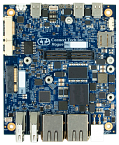 Rogue
Carrier for NVIDIA Jetson AGX Xavier
Connect Tech’s Rogue is a full featured Carrier Board for the NVIDIA Jetson AGX Xavier module. This carrier board for Jetson AGX Xavier is specifically designed for commercially deployable platforms, and has an extremely small footprint of 92×105mm.
The Rogue provides access to an impressive list of latest generation interfaces on the Jetson AGX Xavier while adding additional interfaces of 3x USB 3.1, 2x GbE, 2x HDMI and a locking Mini-Fit Jr. power input connector.
Rugged camera add-on expansion boards will also be available for use with the Rogue to interface directly with the Jetson AGX Xavier high density MIPI CSI interfaces.
Rogue
Carrier for NVIDIA Jetson AGX Xavier
Connect Tech’s Rogue is a full featured Carrier Board for the NVIDIA Jetson AGX Xavier module. This carrier board for Jetson AGX Xavier is specifically designed for commercially deployable platforms, and has an extremely small footprint of 92×105mm.
The Rogue provides access to an impressive list of latest generation interfaces on the Jetson AGX Xavier while adding additional interfaces of 3x USB 3.1, 2x GbE, 2x HDMI and a locking Mini-Fit Jr. power input connector.
Rugged camera add-on expansion boards will also be available for use with the Rogue to interface directly with the Jetson AGX Xavier high density MIPI CSI interfaces.
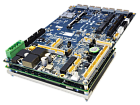 COM Express + GPU Embedded System
A ruggedized small form factor embedded system with GPU
The COM Express + GPU Embedded System from Connect Tech combines Intel Skylake and Kaby Lake x86 processors with high-end NVIDIA Quadro, Tesla, and GeForce Graphics Processing Units (GPU) all into a ruggedized small form factor embedded system. Choose from highest-end, highest-performance models or from low-powered extended temperature models all ideal for high-end encode/decode video applications or GPGPU CUDA processing applications.
This embedded system exposes all of the latest generation interconnect including: Gigabit Ethernet, USB 3.0 and 2.0, DisplayPort++, VGA, LVDS, SATA III, GPIO, I2C, mSATA, miniPCIe, PCIe/104 and SD Card Expansion. This embedded system uses all locking ruggedized positive latching connectors.
VXG part numbers have Passive Heat Spreaders that are to be installed into a Customer Designed End Thermal Solution. DXG part numbers have an Active Cooling Solution with Integrated Support Frame.
COM Express + GPU Embedded System
A ruggedized small form factor embedded system with GPU
The COM Express + GPU Embedded System from Connect Tech combines Intel Skylake and Kaby Lake x86 processors with high-end NVIDIA Quadro, Tesla, and GeForce Graphics Processing Units (GPU) all into a ruggedized small form factor embedded system. Choose from highest-end, highest-performance models or from low-powered extended temperature models all ideal for high-end encode/decode video applications or GPGPU CUDA processing applications.
This embedded system exposes all of the latest generation interconnect including: Gigabit Ethernet, USB 3.0 and 2.0, DisplayPort++, VGA, LVDS, SATA III, GPIO, I2C, mSATA, miniPCIe, PCIe/104 and SD Card Expansion. This embedded system uses all locking ruggedized positive latching connectors.
VXG part numbers have Passive Heat Spreaders that are to be installed into a Customer Designed End Thermal Solution. DXG part numbers have an Active Cooling Solution with Integrated Support Frame.
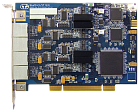 BlueStorm/SP Opto
Serial Communications
The BlueStorm/SP Opto offers the added protection of optical isolatation for your critical applications. The BlueStorm/SP Opto is an extension of the BlueStorm product family and available as a standard profile card only.
Dependability, high speed data transfer rates and 3kV of optical isolation protection makes these cards ideal in environments where harsh conditions may disrupt communications.
Available with 4 ports of RS-232/422/485 connectivity, these BlueStorm/SP Opto cards are compatible with 3.3V and 5V PCI slots.
Bi-directional data speeds up to 1.8432 Mbps (RS-422/485) ensure fast data aquisition and communications.
All BlueStorm/SP Opto products are FCC certified and CE marked.
BlueStorm/SP Opto
Serial Communications
The BlueStorm/SP Opto offers the added protection of optical isolatation for your critical applications. The BlueStorm/SP Opto is an extension of the BlueStorm product family and available as a standard profile card only.
Dependability, high speed data transfer rates and 3kV of optical isolation protection makes these cards ideal in environments where harsh conditions may disrupt communications.
Available with 4 ports of RS-232/422/485 connectivity, these BlueStorm/SP Opto cards are compatible with 3.3V and 5V PCI slots.
Bi-directional data speeds up to 1.8432 Mbps (RS-422/485) ensure fast data aquisition and communications.
All BlueStorm/SP Opto products are FCC certified and CE marked.
 Cogswell
Cogswell Carrier for NVIDIA Jetson TX2 and Jetson TX1
Connect Tech’s Cogswell Carrier for NVIDIA® Jetson™ TX2 and Jetson TX1 is ideal for use in Gigabit Ethernet Vision applications. This product provides Gigabit Ethernet channels with built-in Power over Ethernet (PoE) sourcing capabilities, ideal for use with GigE Vision cameras.
Cogswell’s design includes a total of 5 Gigabit Ethernet Ports. Four of these ports can be used for IEEE 802.3af (PoE) 15.4W power sourcing or two of these ports can be used for IEEE 802.3at (PoE+) 25.5W power sourcing. Additionally the Cogswell Carrier also enables HDMI Video, USB 3.0, USB 2.0, USB OTG, Mini-PCIe/mSATA expansion, and two RS-232 Serial Ports.
Cogswell
Cogswell Carrier for NVIDIA Jetson TX2 and Jetson TX1
Connect Tech’s Cogswell Carrier for NVIDIA® Jetson™ TX2 and Jetson TX1 is ideal for use in Gigabit Ethernet Vision applications. This product provides Gigabit Ethernet channels with built-in Power over Ethernet (PoE) sourcing capabilities, ideal for use with GigE Vision cameras.
Cogswell’s design includes a total of 5 Gigabit Ethernet Ports. Four of these ports can be used for IEEE 802.3af (PoE) 15.4W power sourcing or two of these ports can be used for IEEE 802.3at (PoE+) 25.5W power sourcing. Additionally the Cogswell Carrier also enables HDMI Video, USB 3.0, USB 2.0, USB OTG, Mini-PCIe/mSATA expansion, and two RS-232 Serial Ports.
 Blue Heat/Net Sync
Ethernet-to-Serial solution for data communications
Connect Tech’s Blue Heat/Net Sync offers a synchronous Ethernet-to-serial solution for data communications.
Based on the robust uCLinux (Linux embedded operating system), the Blue Heat/Net Sync can be programmed with application specific protocols. Blue Heat/Net Sync incorporates multiple electrical interfaces and remote configurability to free devices from a physical connection. Remote access increases location flexibility and simplifies future installations or upgrades, reducing costs.
The Blue Heat/Net Sync can be configured and controlled via serial interface or remotely via web based HTTP. With the option to boot from on-board Flash memory or a network location, updating devices in the field can be done from a central location.
Blue Heat/Net Sync
Ethernet-to-Serial solution for data communications
Connect Tech’s Blue Heat/Net Sync offers a synchronous Ethernet-to-serial solution for data communications.
Based on the robust uCLinux (Linux embedded operating system), the Blue Heat/Net Sync can be programmed with application specific protocols. Blue Heat/Net Sync incorporates multiple electrical interfaces and remote configurability to free devices from a physical connection. Remote access increases location flexibility and simplifies future installations or upgrades, reducing costs.
The Blue Heat/Net Sync can be configured and controlled via serial interface or remotely via web based HTTP. With the option to boot from on-board Flash memory or a network location, updating devices in the field can be done from a central location.
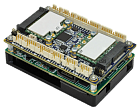 COM Express Type 10 Mini Carrier Board
Connect Tech's COM Express® Type 10 Mini Carrier Board is an extremely small carrier board featuring rugged, locking connectors and offers the ultimate in durability.
COM Express® Type 10 Mini Carrier Board is ideal for space constrained applications, harsh environments, demanding conditions and supports extended temperature ranges of -40°C to +85°C.
COM Express Type 10 Mini Carrier Board
Connect Tech's COM Express® Type 10 Mini Carrier Board is an extremely small carrier board featuring rugged, locking connectors and offers the ultimate in durability.
COM Express® Type 10 Mini Carrier Board is ideal for space constrained applications, harsh environments, demanding conditions and supports extended temperature ranges of -40°C to +85°C.
 Orbitty
Carrier for NVIDIA Jetson TX2 & Jetson TX1
Connect Tech’s Orbitty Carrier for NVIDIA® Jetson™ TX2 or Jetson™ TX1 is designed to match the NVIDIA® Jetson™ TX2 or Jetson™ TX1 module form factor. The Orbitty’s design includes 1x USB 3.0, 1x USB 2.0 OTG, 1x HDMI, 1x GbE, 1x microSD, 2×3.3V UART, I2C, and 4x GPIO. Ideal for robotics and unmanned applications or any small form factor rugged environment.
Orbitty
Carrier for NVIDIA Jetson TX2 & Jetson TX1
Connect Tech’s Orbitty Carrier for NVIDIA® Jetson™ TX2 or Jetson™ TX1 is designed to match the NVIDIA® Jetson™ TX2 or Jetson™ TX1 module form factor. The Orbitty’s design includes 1x USB 3.0, 1x USB 2.0 OTG, 1x HDMI, 1x GbE, 1x microSD, 2×3.3V UART, I2C, and 4x GPIO. Ideal for robotics and unmanned applications or any small form factor rugged environment.
